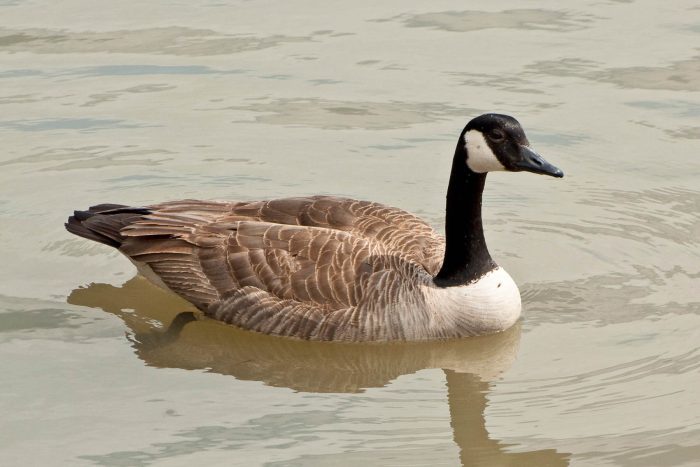Canada Goose
Branta canadensis
The Canada goose is a large, plump bird with a brownish back and a long, black neck. It is a common visitor to the Chesapeake Bay region from autumn through spring. Many Canada geese also live in the Bay watershed year-round.
This section shows one large critter image at a time. Use the thumbnails that follow to select a specific image to display here.

This gallery contains a grid of small thumbnails. Selecting a thumbnail will change the main image in the preceding section.
Appearance
The Canada goose has a brownish-gray back with tan or cream breast and underparts. It has a long, black neck and black head with a white “chinstrap” across the chin and cheeks. Its bill is black and rounded. It has a black tail with a white, U-shaped band on the rump. Canada geese grow to an average of 45 inches in length with a wingspan of about 68 inches, but can vary greatly in size.
Feeding
The Canada goose feeds primarily on corn and grains in farm fields, but also eats bay grasses in the Bay’s shallows. In the water, it feeds by “tipping up” its tail to submerge its head underwater.
Predators
Humans hunt adult geese. Gulls, crows and other large birds may prey on eggs and young geese (called goslings). One or more mature geese usually stands guard against predators while other geese are feeding.
Flight
Flocks fly in wedge- or V-shaped formations, with older birds in front and younger birds in the back. The loud, honking flocks are often heard before they are seen. Geese usually take off from the water by running across the surface and flapping their wings. When they are startled, Canada geese can fly straight up from the water like dabbling ducks. To land, the goose holds its wings out straight and skids onto the land or water. It can be identified in flight by its long, straight neck and white, U-shaped band on its rump.
Voice
The goose has a deep, distinctive honk.
Reproduction and life cycle
Most Canada geese breed in the Arctic, though many now breed in the Bay region. Pairs often mate for life. The female build a nest of reeds, grass and down, usually on the ground near water. The male guards the nest against predators. The female lays 3 to 9 eggs that hatch in about one month. Goslings are fluffy and yellow. They begin to fly 40 to 70 days after birth. Canada geese can live as long as 20 to 25 years.
Did you know?
- Canada geese are the most widespread goose in North America. Scientists believe there are 10 to 11 Canada goose subspecies. The smallest four are now considered a separate species: the cackling goose.
- Some consider resident Canada geese to be a nuisance because they can overgraze on lawns and crops. They also leave feces in parks, yards and other open areas, which is a significant source of pollution in many small, local waterways with large year-round goose populations.
Sources and additional information
- Life in the Chesapeake Bay by Alice Jane Lippson and Robert L. Lippson
- Chesapeake Bay: Nature of the Estuary, A Field Guide by Christopher P. White
- Animal Diversity Web: Branta canadensis – University of Michigan Museum of Zoology
- Waterfowl ID: Canada Goose – Ducks Unlimited
- All About Birds: Canada Goose – The Cornell Lab of Ornithology
